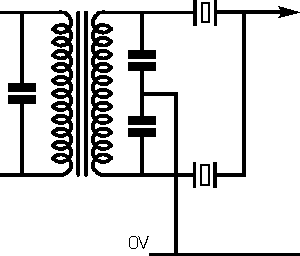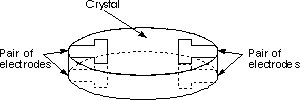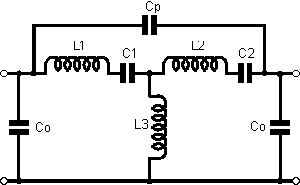Monolithic crystal filter
- summary, tutorial or overview of the basics of the monolithic crystal
filter describing its operation and giving its equivalent circuit.
Quartz crystal filters are widely used in many areas, and in
particular in high performance radio receivers. They are able to offer
unparalleled levels of performance at a cost that represents excellent value for
the performance.
A development of the basic idea of a crystal filter is the
monolithic crystal filter. These monolithic crystal filters are able to offer
even higher levels of performance in some respects while costs are reduced
slightly.
What is a monolithic crystal filter?
Traditionally a crystal filter is made from a number of
discrete crystals with the circuit often based around the half lattice network.
However these designs require the use of a number of individual crystals - often
six or eight are used to give the required performance.

Circuit diagram of a half lattice crystal filter
Rather than having a number of discrete crystals a monolithic
filter uses a single crystal element and two sets of elements are placed on
this. Like most crystals used for radio frequency applications an AT cut is used
- the cut of the crystal is defined by the angle at which the blank is cut from
the original quartz crystal and the angle of cut defines many of the properties
of the crystal blank and hence the overall filter.
The two sets of electrodes are placed onto the crystal. The
electrodes are coupled to each other by the mechanical resonances in the crystal
to give a highly selective filter.

Diagram of a monolithic crystal filter
The filter crystal is grown and cut in the same way as that
used for normal crystals. Although quartz occurs naturally, and was used at one
time for crystal manufacture, most of the material used today is manufactured
synthetically. This has the advantage that the crystals are formed under much
tighter conditions quality is more uniform. Additionally some of the flaws
existing in natural quartz are not present making the overall quality much
higher.
Once the raw crystal has been formed it is cut into blanks
which are lapped and polished to a very high degree. The final stages of
manufacture usually involve chemical etching as this gives a much finer finish.
As a result the effects of ageing are greatly reduced. The size is very
important because this determines the final resonant frequency.,/p>
Once the blank has been completed the electrodes are
deposited onto the quartz. These are normally aluminium, silver or gold, and
they have to be deposited under very controlled conditions so that they cover
the required area and have the correct thickness. The thickness of the
electrodes can be used to trim the filter to its exact resonant frequency.
Making the electrodes slightly thicker reduces the frequency allowing the final
performance to meet very stringent requirements.
Monolithic crystal filter operation
Like the standard quartz crystal, the monolithic crystal
filter relies upon the piezo-electric effect that is exhibited in quartz for its
operation. When signals appear across one pair of electrodes they set up
mechanical vibrations on the crystal. These are affected by the mechanical
resonances of the crystal element, and only those signals within the pass-band
of the filter are allowed across the crystal to be picked up by the second pair
of electrodes.
The operation of the filter can be explained in terms of an
equivalent circuit. From this it can be sent hat there are two series resonant
circuits consisting of L1 / C1 and L2 / C2. The actual values of these
equivalent components are determined by the mechanical dimensions and properties
of the quartz element.

Equivalent circuit of a monolithic crystal filter
There are other constituents to the circuit. L3 represents
the internal coupling between the two resonant circuits whereas Co and Cp are
the parasitic capacitances in the circuit. Co is the capacitance between the top
and bottom plates at either end of the quartz element. For the sake of this
explanation it is assumed to be the same at either end. Cp is the parasitic
leakage capacitance across the resonant element. This needs to be kept as small
as possible to prevent signal leakage across the filter which would impair its
stop band performance.,/p>
These filters are normally designed for operation below about
30 MHz as it is easier and cheaper to obtain a good level of performance at
these frequencies. Additionally there is a lower reject rate because operation
at higher frequencies results in the manufacture of crystals that are very thin
and fragile. Where operation at high frequencies is required, they can be run in
an overtone mode, and this results in them being larger, and hence more robust,
than if they were designed for fundamental frequency operation.,/p>
Summary
Although often cheaper than a crystal filter made from
discrete components, a monolithic crystal filter can still be expensive.
Nevertheless monolithic crystal filters are able to provide a high level of
performance Also with quartz crystal technology improving, their cost is likely
to fall somewhat over the years and the performance improve steadily.
|

